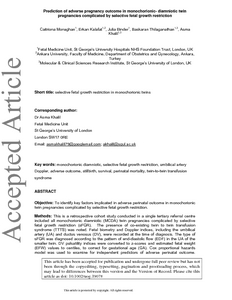Monaghan, C; Kalafat, E; Binder, J; Thilaganathan, B; Khalil, A
(2019)
Prediction of adverse pregnancy outcome in monochorionic diamniotic twin pregnancy complicated by selective fetal growth restriction.
Ultrasound Obstet Gynecol, 53 (2).
pp. 200-207.
ISSN 1469-0705
https://doi.org/10.1002/uog.19078
SGUL Authors: Khalil, Asma
![[img]](https://openaccess.sgul.ac.uk/109816/1.hassmallThumbnailVersion/Monaghan_et_al-2017-Ultrasound_in_Obstetrics_%2526_Gynecology.pdf)  Preview |
|
PDF
Published Version
Available under License ["licenses_description_publisher" not defined].
Download (1MB)
| Preview
|
Abstract
Objective
To identify key factors associated with adverse perinatal outcome in monochorionic diamniotic twin pregnancy complicated by selective fetal growth restriction (sFGR).
Methods
This was a retrospective cohort study of all monochorionic diamniotic twin pregnancies diagnosed with sFGR at ≥ 16 weeks' gestation, in a single tertiary referral center between March 2000 and May 2015. The presence of coexisting twin–twin transfusion syndrome (TTTS) was noted. Fetal biometry and Doppler indices, including those of the umbilical artery (UA) and ductus venosus (DV), were recorded at the time of diagnosis. The type of sFGR was diagnosed according to the pattern of end‐diastolic flow in the UA of the smaller twin. DV pulsatility indices for veins (DV‐PIV) were converted to Z‐scores and estimated fetal weight values to centiles, to correct for gestational age (GA). Cox proportional hazards model was used to examine for independent predictors of adverse perinatal outcome, which was defined according to survival and included both intrauterine fetal demise and neonatal death of the FGR twin.
Results
We analyzed 104 pregnancies, of which 66 (63.5%) were diagnosed with Type‐I and 38 (36.5%) with Type‐II sFGR at initial presentation. In pregnancies complicated by Type‐II sFGR, the diagnosis of sFGR was made earlier than in those complicated by Type‐I sFGR (mediam GA, 19.6 vs 21.5 weeks; P = 0.012), and Type‐II sFGR was associated with increased risk of adverse perinatal outcome (intrauterine demise of the smaller twin, 34.2% vs 10.6%; P = 0.004). Twin pregnancies complicated by sFGR resulting in perinatal demise had a significantly earlier diagnosis (P = 0.002) and lower birth‐weight centile of the smaller twin (P < 0.01), those with Type‐I sFGR had earlier GA at delivery (P = 0.007) and those with Type‐II sFGR had higher DV‐PIV Z‐score of the smaller twin (P = 0.003), when compared with pregnancies resulting in live birth. Coexisting TTTS had no significant impact on the perinatal outcome of pregnancies diagnosed with either Type‐I or Type‐II sFGR (P > 0.05 for both). Earlier GA at diagnosis (hazard ratio (HR), 0.70 (95% CI, 0.56–0.88); P = 0.002), Type‐II sFGR (HR, 3.53 (95% CI, 1.37–9.07); P = 0.008) and higher DV‐PIV Z‐score (HR, 1.36 (95% CI, 1.12–1.65); P = 0.001) were significantly associated with increased risk of adverse perinatal outcome of the smaller twin.
Conclusions
Pregnancies complicated by Type‐II sFGR are diagnosed significantly earlier and are associated with increased risk of adverse perinatal outcome compared with those with Type‐I sFGR. Coexisting TTTS has no significant impact on the perinatal outcome of pregnancies diagnosed with either Type‐I or Type‐II sFGR. Earlier GA at diagnosis, Type‐II sFGR and higher DV‐PIV Z‐score are associated significantly with increased risk of adverse perinatal outcome of the smaller twin.
| Item Type: |
Article
|
| Additional Information: |
This is the peer reviewed version of the following article: Monaghan, C. , Kalafat, E. , Binder, J. , Thilaganathan, B. and Khalil, A. (2019), Prediction of adverse pregnancy outcome in monochorionic diamniotic twin pregnancy complicated by selective fetal growth restriction. Ultrasound Obstet Gynecol, 53: 200-207, which has been published in final form at https://doi.org/10.1002/uog.19078. This article may be used for non-commercial purposes in accordance with Wiley Terms and Conditions for Use of Self-Archived Versions. |
| Keywords: |
adverse outcome, monochorionic diamniotic, perinatal mortality, selective fetal growth restriction, stillbirth, survival, twin-to-twin transfusion syndrome, umbilical artery Doppler, Obstetrics & Reproductive Medicine, 1114 Paediatrics And Reproductive Medicine |
| SGUL Research Institute / Research Centre: |
Academic Structure > Molecular and Clinical Sciences Research Institute (MCS) |
| Journal or Publication Title: |
Ultrasound Obstet Gynecol |
| ISSN: |
1469-0705 |
| Language: |
eng |
| Publisher License: |
Publisher's own licence |
| PubMed ID: |
29704280 |
| Dates: |
| Date |
Event |
| 2019-02-05 |
Published |
| 2018-04-28 |
Published Online |
| 2018-04-10 |
Accepted |
|
 |
Go to PubMed abstract |
| URI: |
https://openaccess.sgul.ac.uk/id/eprint/109816 |
| Publisher's version: |
https://doi.org/10.1002/uog.19078 |
Statistics
Item downloaded times since 10 May 2018.
Actions (login required)
 |
Edit Item |



